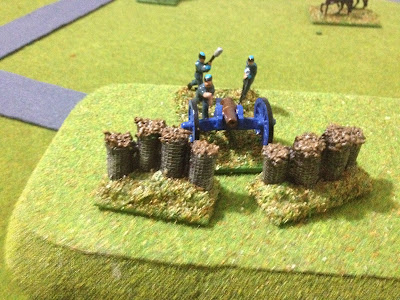 |
| Materials used - dowel and a flyscreen repair kit |
 |
| Cut the flyscreen repair material to size (which has a sticky side) and wrap around the dowel. |
 |
| Cut off the end bit which has been wrapped |
 |
| First Gabion completed |
 |
| Once a few Gabions have been made they are glued together on a stand |
 |
| Add some small stones to the tops of the Gabions |
 |
| Cover with PVA glue |
 |
| Once the PVA glue is dry they are painted with a dark brown |
 |
| Dry brush the Gabions with a light grey and a mid-brown on the tops |
 |
| Ready for a varnish |
 |
| In use |
 |
| A game in progress |
What a relatively easy solution to excellent looking gabions! I may give your technique a try.
ReplyDeleteLike you, I enjoy gridded games for their ease of movement, faster play, and less fiddliness. The difficulty I have is with terraining a grid with free form terrain and actually laying down the grid. Sometimes I feel like a grid, sometimes I don't!
I will be making a few more gabions this coming weekend as I try and finish off more of my 19th century miniatures.
DeleteAs to whether I play grid or not for the 19th century period, I will pause that idea and return to it after playing another period for a bit.
Peter,
ReplyDeleteVery good solution to Gabions- cleverly- well done. Cheers. KEV.
Thanks KEV. Quick and easy too! Peter
DeleteGabions - nicely thought out and processed.
ReplyDeleteThank you. It was good to use up the remaining flyscreen leftover from making some medieval fences. Keeps the costs down.
DeleteI'm definitely going to give this gabion idea a try! Thanks.
ReplyDeleteThey turned out better than I expected.
DeleteThese look really good! Thanks for this, Im feeling motivated to have a go myself,
ReplyDeleteAndy
I am glad the post was useful.
Delete